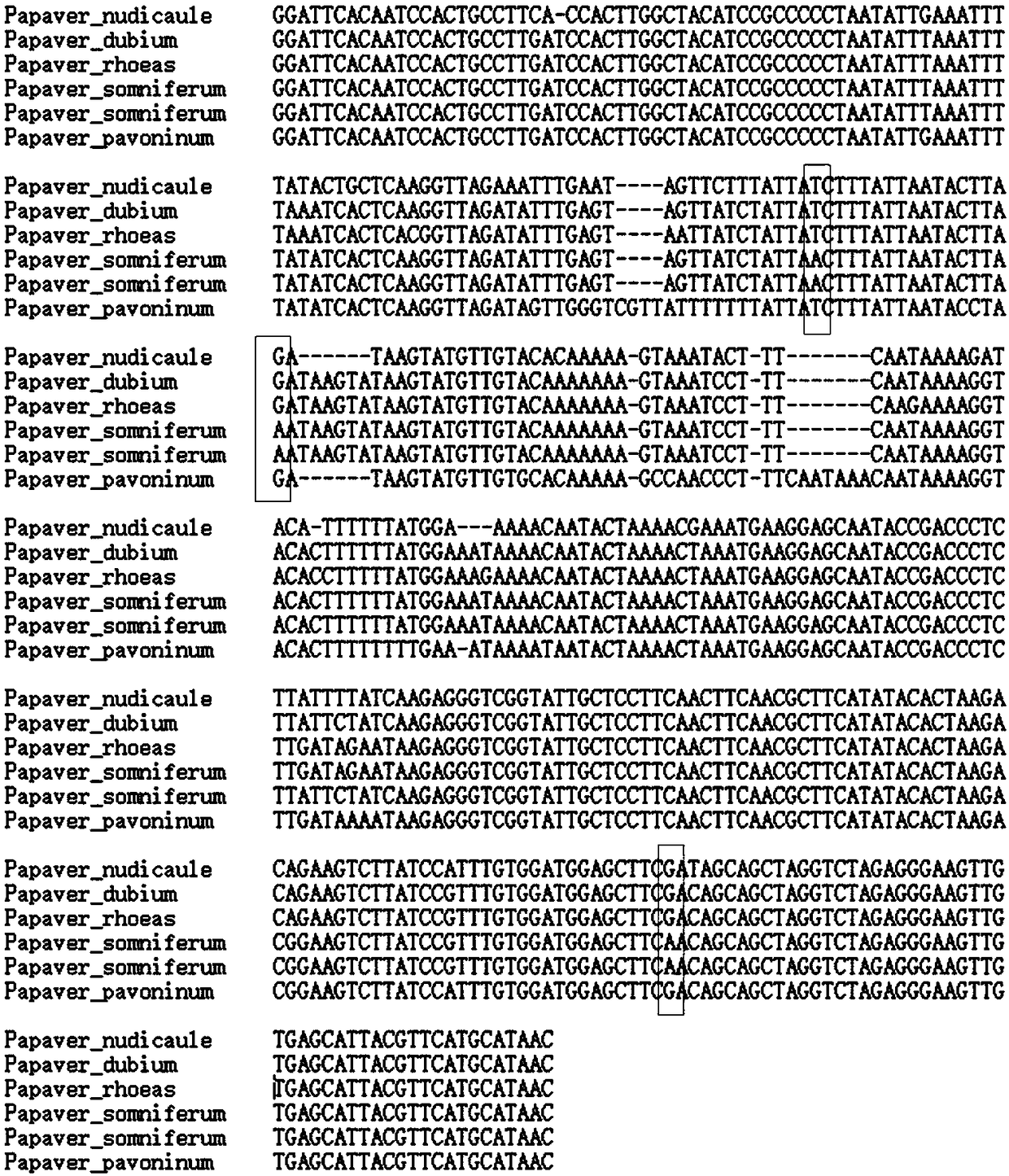Method for identifying opium poppy by using chloroplast DNA bar code
An identification method and barcode technology, applied in the field of molecular identification, can solve the problems of low accuracy, unsafe, poor reliability, etc., and achieve the effect of fast detection process and high accuracy of results.
- Summary
- Abstract
- Description
- Claims
- Application Information
AI Technical Summary
Problems solved by technology
Method used
Image
Examples
Embodiment 1
[0024] The present invention increases the number of individuals as much as possible by widely sampling the plants of the genus Papaver distributed in China, constructs a database of chloroplast DNA barcodes of the plants of the genus, finds the unique information sites of the DNA barcodes of poppy (opium) by comparison, and further obtains its unique DNA barcode.
[0025] The poppy DNA barcode of the present invention is amplified from four fragments matK, psbA-trnH, rbcL and trnL-trnF, and the total length is 2645bp. In this sequence, the specific recognition sites are: 105bp is A, 121bp is A, 333bp is A, 748bp is T, 1539bp is G, 1751bp is A, 2392bp is G, 2604bp for A. What the amplification primer of the present invention adopts is common DNA bar code universal primer, there are 8 specific recognition sites in the sequence of 2645bp that amplifies, can identify opium poppy (opium) according to the base type of above-mentioned specific site .
[0026] The poppy DNA barcod...
Embodiment 2
[0047] 1. Collection and protection of specimens of Poppy plants:
[0048] Consult the literature and the collection information of domestic herbaria, formulate a sampling plan according to the sampling requirements of DNA barcodes, collect individuals from different sources in the distribution area of each species as much as possible, and dry the leaves of all individuals with silica gel. There are 7 species of Papaver, and the total number of individuals is the leaf material of 25 individuals (including variants). The sequence information of some samples is downloaded from the NCBI gene bank (total 165 sequences). Among them, the samples of opium poppy (opium) came from wild sporadic growth in the wild in Ili, Xinjiang, and 3 leaf samples were collected from each location. See Tables 1 and 2 for the list of materials and sources of samples.
[0049] Table 1 Specimens and sources of Papaver
[0050]
[0051] Table 2 Primers and Genebank numbers of Poppy plants
[0052...
Embodiment 3
[0092] With the flowerless and fruitless poppy and other poppy leaves collected in medicinal planting areas and in the field as materials, the method in Example 1 was used for DNA extraction, PCR amplification and sequencing, and the identification results showed that in the known poppy plants The 105th bp of the obtained DNA barcode sequence was A, the 121st bp was A, the 333rd bp was A, the 748th bp was T, the 1539th bp was G, the 1751st bp was A, the 2392th bp was G, and the 2604th bp was A. However, the above-mentioned specific sites were not found in other unknown plants of the genus Papaver, so the samples of Papaver could be identified.
[0093] The sequence list of the present invention is the trnH, matK, rbcL, trnL sequence of a poppy (Papaver somnferium) individual of the present invention, and there are 7 bases missing in comparison with other species.
PUM
 Login to View More
Login to View More Abstract
Description
Claims
Application Information
 Login to View More
Login to View More - R&D
- Intellectual Property
- Life Sciences
- Materials
- Tech Scout
- Unparalleled Data Quality
- Higher Quality Content
- 60% Fewer Hallucinations
Browse by: Latest US Patents, China's latest patents, Technical Efficacy Thesaurus, Application Domain, Technology Topic, Popular Technical Reports.
© 2025 PatSnap. All rights reserved.Legal|Privacy policy|Modern Slavery Act Transparency Statement|Sitemap|About US| Contact US: help@patsnap.com



